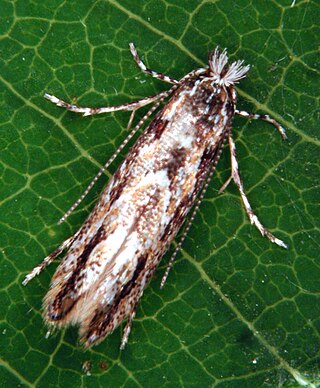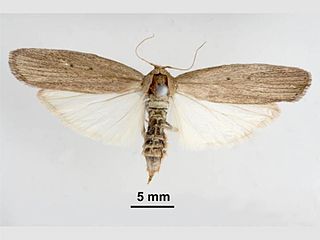
Gracillariidae is an important family of insects in the order Lepidoptera and the principal family of leaf miners that includes several economic, horticultural or recently invasive pest species such as the horse-chestnut leaf miner, Cameraria ohridella.

Anthophila fabriciana, also known as the common nettle-tap, is a moth of the family Choreutidae first described in 1767 by Carl Linnaeus. The moth can be found flying around stinging nettles during the day.

Stenoptilia bipunctidactyla, also known as the twin-spot plume is a moth of the Pterophoroidea family found in North Africa, Asia and Europe. It was first described by the Austrian physician and naturalist, Giovanni Antonio Scopoli in 1763. It is one of four similar looking moths.

Agrotis longidentifera, the brown cutworm, is a moth of the family Noctuidae described by George Hampson in 1903. It is found in eastern and southern Africa and several islands in the Indian Ocean.

Psorosticha zizyphi, the citrus leaf roller, is a moth of the family Depressariidae.

Olindia schumacherana, also known as the white-barred tortrix, is a moth of the family Tortricidae found in most of Europe. The moth was first described by the Danish zoologist, Johan Christian Fabricius in 1787.

Choreutis nemorana, the fig-tree skeletonizer moth or fig leaf roller, is a species of moth of the family Choreutidae.

Uresiphita polygonalis is a moth of the family Crambidae. The species was described by Michael Denis and Ignaz Schiffermüller in 1775. It is found in the Pacific, including Hawaii and New Zealand, Sri Lanka, Europe and northern and southern Africa.

Tebenna gnaphaliella, the everlasting tebenna moth, is a moth of the family Choreutidae. It is found from Florida to California and north at least to New Hampshire.

Lithocolletinae is a subfamily of insects in the moth family Gracillariidae. It is distributed worldwide, with most species in temperate regions.

Oraesia emarginata is a species of moth of the family Erebidae first described by Johan Christian Fabricius in 1794. It is found in Australia, New Caledonia, Indonesia, New Guinea, Pakistan, the Philippines, India, Sri Lanka, Sulawesi, Taiwan, China, Japan, Korea and Nepal as well as Eritrea, Ethiopia, Kenya, Namibia, Nigeria, South Africa, Tanzania, the Gambia, Uganda, Oman and Yemen.

Eldana is a genus of moths of the family Pyralidae containing only one species, the African sugar-cane borer, which is commonly found in Equatorial Guinea, Ghana, Mozambique, Sierra Leone and South Africa. Adults have a wingspan of 35mm. This species is particularly relevant to humans because the larvae are a pest of the Saccharum species as well as several grain crops such as sorghum and maize. Other recorded host plants are cassava, rice and Cyperus species. When attacking these crops, E. saccharina bores into the stems of their host plant, causing severe damage to the crop. This behavior is the origin of the E. saccharrina's common name, the African sugar-cane borer. The African sugar-cane borer is a resilient pest, as it can survive crop burnings. Other methods such as intercropping and parasitic wasps have been employed to prevent further damage to crops.
Euclasta varii is a species of moth in the family Crambidae. The species is found in Spain, Algeria, Tunisia, Libya, Angola, the Democratic Republic of Congo, Malawi, Mozambique, Senegal, Sierra Leone, South Africa, Tanzania, Zimbabwe, Zambia and Yemen.

Polydesma umbricola, the monkeypod moth or large tabby, is a species of moth in the family Erebidae. The species is found in southern Europe, Africa, Asia Minor to southern Asia, of India, Sri Lanka, Maldives, the Andaman Islands, including many Indian Ocean islands, like Coëtivy Island, Aldabra, Assumption Island, Madagascar and on Hawaii.

Thalassodes quadraria is a species of moth of the family Geometridae first described by Achille Guenée in 1857. It is found in Africa south of the Sahara and in India and Sri Lanka.

Banisia myrsusalis, the sapodilla borer or sapota midrib folder, is a species of moth of the family Thyrididae. It was described by Francis Walker in 1859 and is found in North America, Brazil, Australia, southern Asia and Africa.

Alysicarpus vaginalis is a species of flowering plant in the legume family, Fabaceae. It is native to parts of Africa and Asia, and it has been introduced to other continents, such as Australia and the Americas. It is cultivated as a fodder for livestock, for erosion control, and as a green manure. Common names include alyce clover, buffalo clover, buffalo-bur, one-leaf clover, and white moneywort.
Scrobipalpa ergasima is a moth of the family Gelechiidae. Edward Meyrick first used the scientific name in 1916. It is found in the Mediterranean Region and on the Canary Islands. Outside of Europe, it is found in Egypt, Saudi Arabia, the Democratic Republic of the Congo, Namibia, South Africa, Sudan, Australia, India, Indonesia, Myanmar and Pakistan.
Brachiolia egenella is a species of moth of the family Tortricidae first described by Francis Walker in 1864. It is found in Sri Lanka, India, South Africa and on the Comoros and Mauritius.

















